How to Make Lilac Jelly (Yes, Lilacs are Edible)
This post may contain affiliate links. Read my full disclosure here.
Lilac jelly is one of the easiest flower jellies to make, because the lilac flowers are so abundant. They’re one of my favorite parts of spring, with their heady aroma filling the countryside.
We had a bumper crop of lilacs this year. My neighbor commented that his lilac bushes so full of blossoms that he couldn’t see the leaves. Our lilac bush was loaded, too, so it seemed like a good year to experiment with eating some of the flowers.
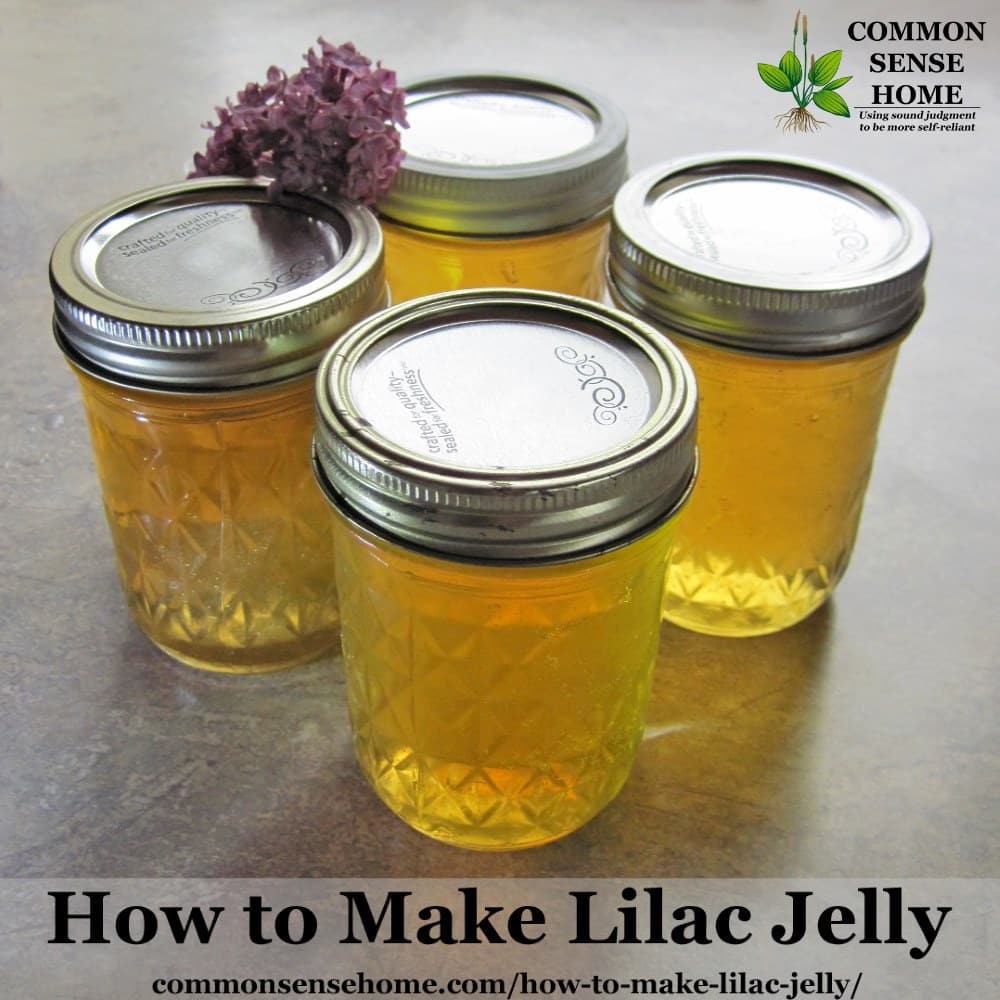
A friend made candied lilacs for her daughter’s birthday by brushing the blossoms with egg white and sprinkling them with superfine sugar. I didn’t think that would have much appeal for my boys, as they generally prefer volume to intricacy.
Lovely Lilac Jelly Recipe
Instead, I went hunting for a lilac jelly recipe. You could also adapt this recipe for use with any strong flavored/scented edible flowers.
Make sure that your lilacs (or other blooms) have not been sprayed with chemicals, and avoid high traffic areas. (Well traveled roadsides are not good for foraging.)
See our Edible Flowers List for more flower jelly ideas.
The flowers I used for my jelly were light purple, which gave me a bright yellow jelly. Dark purple flowers will give you a darker jelly.
Make sure to pull the blossoms off of the stems, as stems can make the jelly bitter. You don’t need to wash the flowers unless you think they might be dusty. (They get sterilized by boiling water and the canning process.)
Note that although the recipe card has an option to double or triple the recipe, it’s best to make it in single batches. With a double or triple batch, it takes longer for the jelly to heat through. The quality will be better with a single batch at a time.
Ingredients
- 2 cups packed lilac blossoms, no leaves, no stems
- 2 1/2 cups boiling water
- 1/4 cup lemon juice
- 4 cups sugar
- One box Sure-jell powdered pectin (1.75 oz, or just over 4 tablespoons pectin)
Instructions
First, infuse the blossoms in the water to make a “lilac tea”.
Place the blossoms in a heat resistant container and pour the boiling water over. Allow them to steep 8 hours or overnight.
When ready to can, sterilize four 8-ounce jars or eight 4 ounce jars, keep hot. Heat lids and rings in hot water, keep warm but not boiling. Fill water bath canner and bring to boil.
Strain the flowers out of the water. Squeeze dry. You should have 2 1/4 cup of lilac infused water. Add more water if needed.
Would you like to save this?
I allowed the strained liquid to sit in the refrigerator overnight, and then poured it off carefully. This allowed some of the particles to settle out of the infusion, resulting in a clearer jelly.
Place the flower infusion, lemon juice, and pectin in a large heavy bottom pot. Bring to a rolling boil.
Add sugar all at once, return to boil. Boil for one minute, stirring constantly. Skim foam if needed. Remove from heat.
Ladle jam into hot, sterilized jars leaving 1/4″ headspace. Wipe rims clean and screw on the lids.
Process for 10 minutes in water bath canner (add 1 minute for every 1,000 feet above sea level).
Remove jars from canner and allow to rest until cool. (I prefer overnight.) Remove rings, wipe any drips and label for storage.
Makes around 4 half pint jars or 8 – 4 ounce jars.

Print Friendly Recipe
PrintLilac Jelly
A simple lilac jelly recipe to share or enjoy at home.
- Yield: 4 cups 1x
- Category: Jelly
- Method: Canning
- Cuisine: American
Ingredients
- 2 cups packed lilac blossoms, no leaves, no stems
- 2 1/2 cups boiling water
- 1/4 cup lemon juice
- 4 cups sugar
- One box Sure-jell powdered pectin (1.75 oz, or just over 4 tablespoons pectin)
Instructions
First, infuse the blossoms in the water to make a “lilac tea”.
Place the blossoms in a heat resistant container and pour the boiling water over. Allow them to steep 8 hours or overnight.
When ready to can, sterilize four 8-ounce jars or eight 4 ounce jars, keep hot. Heat lids and rings in hot water, keep warm but not boiling. Fill water bath canner and bring to boil.
Strain the flowers out of the water. Squeeze dry. You should have 2 1/4 cup of lilac infused water. Add more water if needed.
Place the flower infusion, lemon juice, and pectin in a large heavy bottom pot. Bring to a rolling boil.
Add sugar all at once, return to boil. Boil for one minute, stirring constantly. Skim foam if needed. Remove from heat.
Ladle jam into hot, sterilized jars leaving 1/4″ headspace. Wipe rims clean and screw on the lids.
Process for 10 minutes in water bath canner (add 1 minute for every 1,000 feet above sea level).
Remove jars from canner and allow to rest until cool. (I prefer overnight.) Remove rings, wipe any drips and label for storage.
Makes around 4 half pint jars or 8 – 4 ounce jars.
Notes
I allowed the strained liquid to sit in the refrigerator overnight, and then poured it off carefully. This allowed some of the particles to settle out of the infusion, resulting in a clearer jelly.
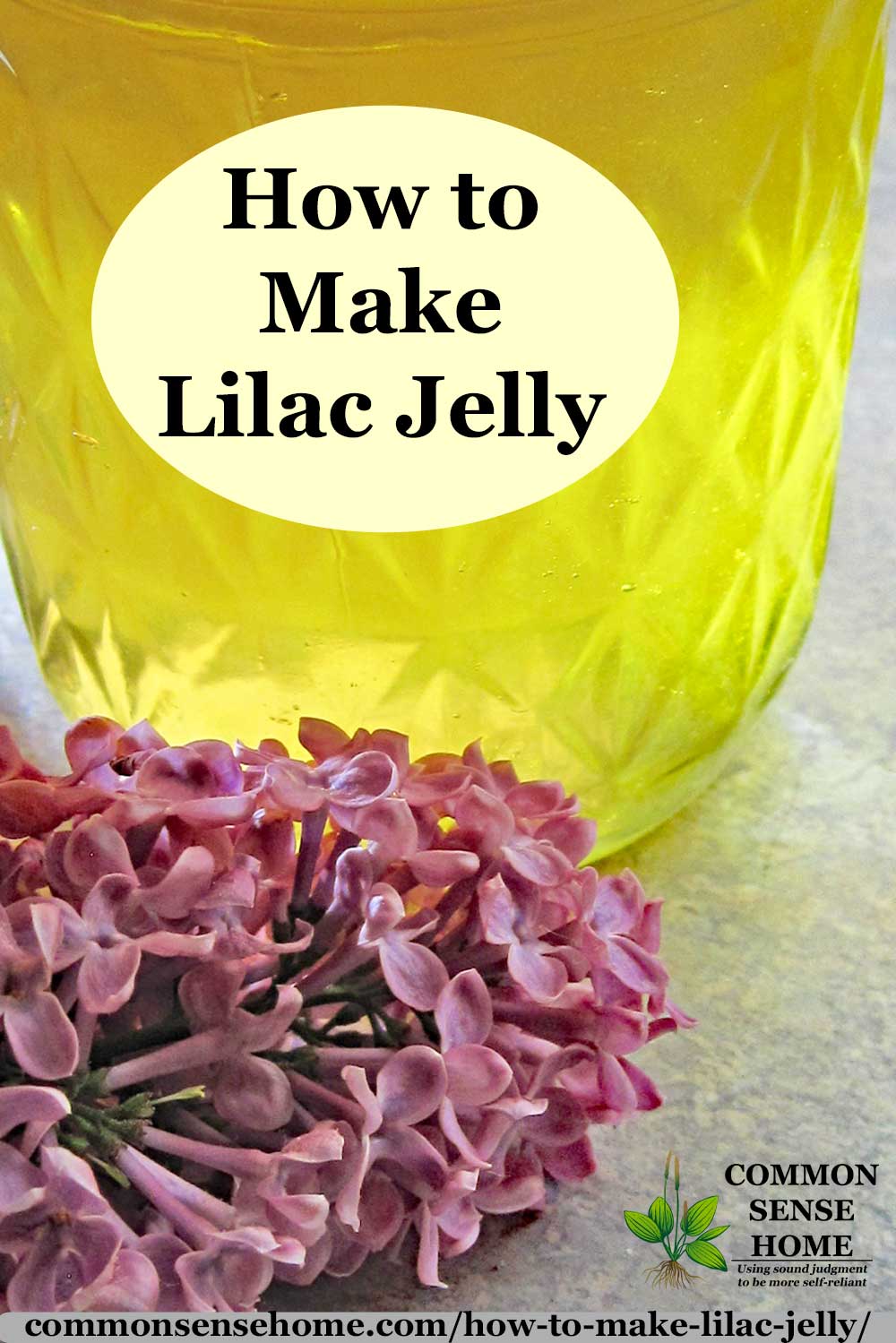
I found the flavor to be very mild and lightly floral. It improved overnight. (I saved the skimmed jelly and put it in the refrigerator to sample.)
My youngest said, “I liked it. It was very yummy!”
It’s high in sugar, so this certainly falls into the “treat” category, but it was a fun experiment. My neighbor was shocked to find out that her lilacs were edible. 🙂
More Made from Scratch Recipes and Information on Using Wild Plants for Food and Medicine
Don’t forget to check out the Recipes page for more jam and jelly recipes, including:
- Elderberry Jelly Recipes – Low Sugar and Sure-Jell Options
- Violet Jelly
- Low Sugar Dandelion Jelly
- Queen Anne’s Lace Jelly with Currants
- Apple Blossom Jelly – A Great Use for Flowering Crab Apples
Originally posted in 2013, last updated in 2020.

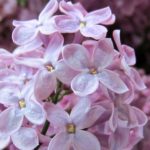

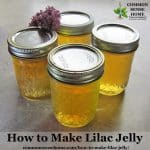
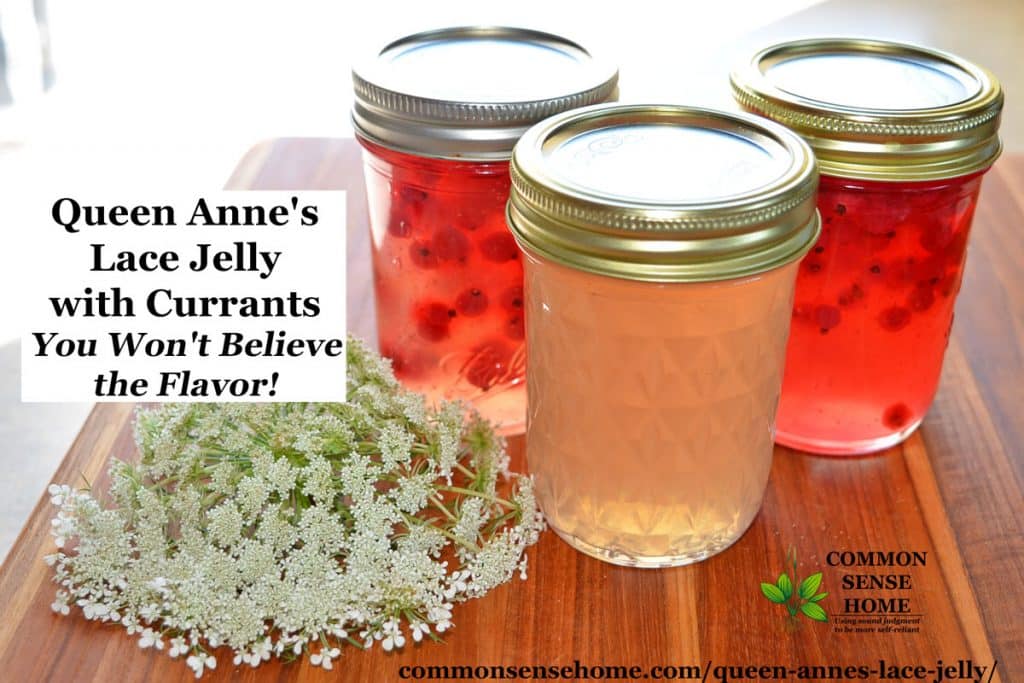
I have not made the jelly yet. My question is, has anyone just left the flowers in and made jelly that way? If so, how did it turn out? Thank you melissa
The flowers tend to discolor during the steeping process, and aren’t very pretty anymore. If you wanted to add in a few fresh blossoms as you are putting the jelly in jars, they should be preserved for a time (rather like sugared lilacs). I’d use those jars fairly quickly, as odds are you’ll get little pockets of liquid forming around the blossoms as the sugar in the jelly draws the moisture out of the flowers. How much water the flowers give off will vary with rainfall and available water to the tree. If you’re serving the jelly during lilac season, you could pour it into a serving bowl and sprinkle the flowers on top to highlight the flowers.
Seriously DELICIOUS!!! Don’t think about it just do it… I’m not a huge fan of floral tasting things and a friend mentioned doing Lilac’s because I was making RedBud Jelly that week. I was like meh ok maybe… another friend & I agreed to swap some jelly because she was going to make some dandelion jelly and she loves Lilacs. I’m so glad I did!!!! I’m going to be getting more from my Uncles yard this time to leave plenty for the winged friends that need it.
I’m glad you enjoyed it. No redbuds in our area, but I’ve heard that jelly is tasty, too. Each bloom brings a unique flavor, not quite like the flower scent, but tasty.
I just made this today for the very first time. Thank you for sharing the recipe. Will be making it again. Very delicious.
I’m glad it turned out well for you. Our lilacs are just starting to bud out this year.
When I click to triple the recipe everything changes except the pectin….is that right or do I need to triple the pectin also? I’ve only ever made apple jelly and didn’t have to use pectin. Also, do you think apple lilac would be good? I’m thinking I could freeze the infused water until apples are ready in late summer.
Hi Carol.
I wish I had the option to turn off the double/triple the recipe function in the recipe card for some recipes, namely jams and jellies.
For full sugar jam and jelly recipes (like this one), I don’t recommend doubling or tripling the recipe. Why? Because the batch size gets so large that it tends to cook unevenly. The jelly at the outer edge tends to over cook by the time the center heats through, even with stirring. Cooking in single batches works better.
If you were still determined to make a double or triple batch, you would need to double or triple the pectin. I have no idea why the recipe card calculator didn’t do that.
With low sugar jelly recipes, doubling the recipes works better, because the batches are smaller. There’s not more sugar than juice/infused liquid.
If you were making a no added pectin apple lilac jelly, I think the cooking time required to get it to gel, would eliminate some of the more subtle flavors of the lilac. If you add pectin to shorten cook time, you might retain more lilac flavor. If you have plenty of infusion, it doesn’t hurt a thing to try and see how you like the results.
I made two separate batches today. I have some white sort of filmy stuff on the surface. I strained the lilacs with cheese cloth so it’s not from the flowers. Seems to develop during the boiling after adding sugar. Boiling too high? Unresolved sugar? Anybody else experience this? Otherwise, beautiful colour and great recipe.
It’s not unusual for jam and jelly to develop a thin layer of foam that settles into a white film. Typically I just stir it in, as it doesn’t affect the flavor. You can also use a spoon to skim it off. Some older recipes called for a dab of butter to be added to the jam or jelly to reduce foaming.
I’m making this today and mine stayed a pink/purple color. I hope I didn’t do anything wrong. Its very pretty, can’t wait to taste it!!
The color changes some over time. I’m sure it’s fine. 🙂
If I use white lilac will the jelly still look beautiful are do.i need to.put food coloring in it t to make it pretty
I haven’t used white lilacs or seen them used, so I don’t know what color the jelly will be, but you can adjust it if you like.
Made this yesterday, and I tossed in about 15 blueberries into my “tea” to give it a more lilac-like colouring. It tastes great but 24 hours later, it is still quite liquid in the jars. I put some in the fridge and left some on the counter, neither seems to have jelled just yet.
Did you use the recommended amounts of pectin and sugar and recommended cooking time? All are needed for full sugar pectin to work.
I used the 4 cups of sugar, and one pouch of liquid pectin (Bernardin brand). The pouch has 85 mL of pectin (85 mL = 2.87 oz) of liquid pectin. The ones in the fridge are a bit more viscous after 24 hours of refrigeration, but still not quite a jelly. The ones at room temperature (I’m in the middle of a nasty heatwave where I live) are very liquid. I’m sure the ones in the fridge will solidify a bit more.
The liquid pectin is the issue. It tends to provide a softer set than powdered pectin by default. The jelly may set up more over time.
In the future, I’d suggest using powdered pectin, or reducing the flower water liquid by 1/4 cup.
Question? Is the infused liquid supposed to be bitter?
I didn’t taste it, but I wouldn’t be surprised if it had a small amount of bitterness.
I followed the recipe and mine gelled perfectly. It also came out a gorgeous shade of pink (from light purple blooms). I’ll definitely make this jelly again!
I made this lilac jelly today and it is delicious. I have never made lilac jelly before. It took quite a while to get all the tiny flowers off the plant but I just put on a movie and parked myself on the couch. It was worth it and it’s so fun to make something unique. Mine came out a light pink color. Thanks for sharing this wonderful recipe!
You’re welcome, Ginnine.
I just found this recipe on April 26, 2020, picked my light purple lilacs on the 27th and just took my finished jellies out of the water bath canner. My jellies have a beautiful mauve color and taste amazing! I got five 8oz jars and a 4oz jar for tasting throughout the day. Thank you SO MUCH for this recipe!!!
You’re welcome. Glad it worked out well for you.
Does anyone know of a way to do this with with sugar substitute, like monk fruit or similar natural sweetness. Or is sugar the only way?
Technically, the definition of “jelly” is “a sweet, clear, semisolid spread or preserve made from fruit juice and sugar boiled to a thick consistency”, so if you eliminate the sugar, it’s not really jelly anymore.
If you wanted to attempt a flower infusion based spread with less sugar or no sugar, I’d opt for using Pomona’s Universal Pectin, which will gel without sugar. Start with the low sugar dandelion jelly recipe as a base (https://commonsensehome.com/dandelion-jelly/), and substitute your sweetener of choice for the sugar.
I’m not certain how this would work since I have not tried it, but the odds seem pretty good.
I WISH along with the numerous links you do have you would add one for sending by email. I want to share this with EVERYONE I know. WHY haven’t I been told about this DECADES ago? Lilacs have been my all time very favorite flower ever since a little girl and the neighbors had on the property line two very large lilac bushes that while on the line, were still close enough to my one bedroom windows that when a breeze wafted over them I could lie in bed at night and enjoy their lovely aroma. Now, living in our family’s 200+ year old homeplace, where at one point, after my great-grandmother passed away my great-grandfather removed most of the shrubs and bushes she had. They interfered with his mowing. Well I have planted all sorts of varieties of lilacs on the property and it helps to keep the season lasting far longer than what we get with the standard normal lilac most people have. I have to try this.
Multiple lilac type sounds lovely. I’m glad you brought them back.
Just send people the url for the post. 🙂
I couldn’t wait to try this, so I picked a bunch of flowers today – before reading the recipe, ????
I have to work 12 hours tomorrow! ????
Can they steep longer?
Could I freeze the flowers and complete the process later?
Sometimes longer steeping can lead to off flavors, so I’d probably freeze them and process when you have more time.
Are flowers that have a touch of brown on them okay to use?
Maybe. Without is better. Watch for signs of spoilage or unpleasant flavors in the flower water soak.
Just wondering if anyone has tried using dried flowers for the jelly. If I was to measure out the amount according to the recipe and then dry the flowers, would it still work? I am steeping the first batch as we speak and will process it tomorrow. I have used fresh flowers for this but wonder if I could dry and save the flowers for a future batch. I would hate to waste such beautiful flowers;)
I think the flavor may not be as strong, but it should work.
I’m confused. Are you using the strained water or the buds themselves for the jelly. Do any of the buds soaked overnight go into the jelly? TY!
It’s jelly, so as you can see from the photos, no buds. Jelly, by definition, is made with a clear liquid. In the case of flower jellies, the clear liquid is the flower infused water.
After soaking, the flowers aren’t very attractive. They brown and wilt, and would also be rather chewy as part of a spread. If you are making up food for a party and want to dress up your display with the flowers, I’d suggest candying them as described in the first paragraph of the post, or just using them “as is” picked off of the stem.
I have my tea steeping now, but it does not smell anything like lilacs. Is this normal? I waited till close to the end of the season to make this, and it has been raining for a week straight (I wish I was exaggerating) so would the watered down petals make it smell less lilac-y. I am so excited to try this, I make jelly out of just about anything so I want this to turn out well.
Yes, unfortunately extreme levels of precipitation are likely to water down the flavor somewhat.
Is there a website I can go to so that I may buy some? It sounds good but not much lilac in the south
There are sites that list them for sale, but I’d be hesitant to buy them without a guarantee that they are not sprayed with something you don’t want in your jelly. You can make a similar flower jelly from most edible flowers. Maybe there’s something that’s abundant in your area that you could try instead? There’s a post on edible flowers at https://commonsensehome.com/edible-flowers/.
Try fireweed jelly. Use this same recipe. Pick off the blossoms ,,,no green and by all means drink the water you pour off as a tea. Fireweed is amazing and many healing properties.
My jelly turned out perfect except it has a bitter flavor and don’t understand why. Any suggestions ?
Could you have gotten some stem in with the flowers? That’s the most common source of bitterness. If you eat them, you’ll notice the flowers themselves have a mild flavor, but any green is bitter. Otherwise, is there a possibility of contamination? Pesticide and herbicide drift will give off flavors. Was it cooked longer than recommended? This could also produce an off flavor.
made this
came out awesome
not sure on what to serve it with??
Toast with butter and jelly is a classic. You could also serve it with pancakes or waffles, or spread it with a dab of cream cheese on crackers.
Scones and clotted cream!
I haven’t made jellies before so this may be a bad question but is it possible to use stevia or Tru-via instead of sugar?
Not a bad question. You cannot substitute stevia or Truvia for sugar in a standard jam or jelly recipe, or it won’t gel. If you’d like to use less sugar or a sugar substitute, you should use a pectin specifically for low sugar/no sugar jam/jelly, such as Pomona’s Pectin.
I haven’t tried a low sugar/no sugar version of this jelly, but estimating from the dandelion jelly in the book Preserving with Pomona’s Pectin, you’d probably want to use 1/2 cup to 1 cup of Truvia, 2 teaspoons of calcium water (included in the Pomona’s Pectin package) and 2 teaspoons of Pomona’s Pectin.
Can you use honey or part honey instead of all sugar?
Honey will change the flavor and color of the final product, but it should work. Use 3/4 cup of honey for each cup of sugar (so 3 cups honey) and reduce liquid by 1/4 cup for each cup of honey (so use only 1 3/4 cup water to infuse the lilac blossoms).
So nice to see someone post the actual quantities instead of just saying reduce it by X mount or increase it by X amount because there are a lot of math dummies in the world! LOL
Hi Dawn.
I just added a note to the post. I’m not sure if you were thinking about making a double batch, but full sugar jellies work best in single batches.
Hi, I like to substitute Agave for surgery. Woul I follow the same instructions you posted for honey?
Pick your own suggests:
Could the infused liquid be consumed as a nice cold drink? If so, what might be the nutritional value, if any?
There’s no reason you couldn’t drink the infused liquid if you cared to do so. I’m not sure how much if any nutritional qualities would be retained, but here’s an interesting snippet from Scientific American about eating flowers:
If you add 1 teaspoon of citric acid in a 1/4 cup of water and crush or blend the flowers prior to steeping your flowers will not turn brow and will change to a rose pink color. I have not tried this with lemon juice.
Do the flowers have to be open? or can new unopened flowers be used?
I’m not sure, but sniffing around the lilac tree, it seems to me that the flowers reach their maximum aroma (and likely flavor) once they have opened.
My infused liquid looks like ice tea – will it turn the beautiful yellow after I add everything?
Not sure, as I have not had that happen. However it looks, taste should still be similar.
Can you let the flowers soak longer or keep the infused liquid in the refrigerator for several days before making the jelly?
I haven’t tried it, but refrigerating should buy you a couple of days.
Can you double this recpie? I have 4cups of lilacs steeping now.
I know it’s a lit bit of a hassle, but it would be best to process in two batches. Cooking in a single batch allows the liquid to come to temp more quickly and evenly, given the final product a lighter, less “cooked” taste. I have tried double batches of jam and jelly a few times over the years, and while it can be done, I think single batch quality is worth the extra time.
Absolutely do not try to double jelly and jam recipes. My “jammy mentor” Margaret taught me this, and it’s especially critical for recipes not using commercial pectin. Even then, stick to single batches.
I made my Lilac Jelly tonight and it turned out wonderful. I loved the delicate smell of lilacs while it cooked. My jelly came out a beautiful deep pink color… not yellow like yours. I am very pleased. Thanks for sharing.
If you used the darker lilacs, that would help with the color. Mine were very pale. Glad that it turned out well for you.
My jelly is very runny, how long will it take to set. I placed some in the fridge and thickened only slightly.
If your jelly did not set after it cooled, you may have made a mistake in the cooking process. You can either use it “as is” as a syrup, leave it an see if it thickens up over time (I had some grape jelly that set up after a few weeks in storage) or recook with additional low sugar pectin as discussed in “How to Remake Jams and Jellies That Didn’t Set“.
It could be because the instructions doesn’t say to add the pectin at all
I take that back, it has it in the first step ! I can’t wait to try this !
Try 2 packs of pectin per batch if your using the fluid packs or just double the dry mix formulaben
I leave in a country invaded with black flies at Spring time. They stick on the flowers and specially on lilac. I will like to make that jelly but how to get rid of those sticky black flies before infusing them in the water ?
Do the flies have any flavor? If it doesn’t freak you out, they could probably be left in. Otherwise, try a warm rinse with vinegar water, but don’t let them soak too long or you’ll lose the flower flavor.
Can you possibly just pick off the flowers that have the flies stuck to them? I don’t know what your black flies look like, or how big/small they are so am not sure if what I’m saying is do-able. Just a thought.
I have not yet made lilac jelly but a few years ago I made fireweed jelly as that is prominent edible flower in Alaska. I picked the fireweed late in the season and ran into the bug issues. I actually rinsed the petals as best as I could and strained them but ultimately, when I poured the boiling water on the petals, there were bugs. I let the petals and the bugs steep but when I strained it I used cheese cloth. I did not have any bugs in my jelly and it tasted great! I just don’t tell anyone about that part when I give it away as a gift. Haha!
I think it depends on the bugs. Bugs that eat a particular plant often taste/smell similar to that plant.
For instance, broccoli worms taste like broccoli. Most red and bright orange bugs are not pleasant to eat or recommended for eating, like Asian lady beetles. Those things are utterly bitter and revolting in flavor and would ruin any food they were in. A friend of mine did a guest post for the site on eating bugs – https://commonsensehome.com/eating-bugs/
I’m glad your jelly worked out, and thank you for sharing the bug story. Good to know – just in case!
I never heard of lilac jelly. We will have to try this next year. My daughter always likes trying new things. Does the jelly smell as good as the lilacs in bloom?
It’s not nearly as fragrant as the flowers themselves, just a hint of floral scent and flavor.
In the past my lilac bush was exploding with flowers so I asked around for a use for lilac flowers only to be told they are not edible. Imagine my surprise to find out I can make jelly from my lilac bush.
My friend has been eating candied lilacs for years with no ill effects.
Wonder how to make them?
As mentioned in the first paragraph, she simply brushed the blossoms with beaten egg white and sprinkles superfine sugar on them. I would only use local eggs you trust if you want to try this, not factory farmed eggs.
I made lilac jelly this week, as well – we’re drowning in lilacs, and they’re one of my favorite flowers, but their season is so short, and always coincides with putting the garden in or getting day old chicks, so I always miss it! Not this year, though – I finally got a chance to make that jelly I’ve been talking about for the past few years. My recipe is a bit different from yours, but I agree – it makes a very pleasant flavor, and not as overpowering as wild rose jelly. It kind of comes out a different color, though, doesn’t it?
Yup! The flowers oxidize while steeping. I added a little back light to get a brighter photo, but in normal light it looks a bit more golden. No purple to be seen.
I can’t seem to find the comment button, so I’m replying to your comment, maybe you can help me?
I’ve spent the last 8 hrs pulling out pollen and lil’ baby stamens, then I re-read the recipe and it says no leaves or STEMS lol
Can I leave these in or should they are removed?
Any help would be lovely. TIA
All the flowers go in the recipe, if that’s what you’re asking. No need to pull stamens out.
Ty 🙂 I’m guessing the little pollen things are find too then. Seriously. All that work just got me a cup lol. You just saved me another 8 hrs!
I pull the flowers off the stems. No flower dismemberment required.
So someone donated a bunch of lilac for my jelly today but many of them have small amounts of burn from the sun. I have bad lighting to differentiate. Will this affect the taste of my jelly? My guess is it will taste burnt. Do you have any experience with this? Any info would be super. TIA.
I’d suspect what you are looking at is the beginnings of rust/flowers fading, not sunscald, as I have never seen lilacs with sun damage, but I may be mistaken.
I’ve never tried working with flowers that are starting to fade, but everything is sterilized during processing, so spoilage shouldn’t be an issue.
Did you try tasting one to see if it has an “off” flavor? If so, spit out and don’t use them.
Nm. The water was to MAKE the infusion.
Please let me know if I’m wrong and missed something else 😉
Yes, you pour the 2 1/2 cups of boiling water over the blossoms to make the infusion.